Abstract
Aim
The Japan Society of Obstetrics and Gynecology implemented a registry report system for the clinical practice of assisted reproductive technology in 1986. The aggregated results from 1992 to 2014 are reported herein.
Methods and Results
The total number of registered treatments was 393 745 cycles, of which 66 550 were pregnancy cycles and 46 008 were cycles with a live birth. Compared to the number of registered treatments in 2008, when the cycle‐based registry was newly introduced, there was a 2.07‐fold increase in the total number of treatments and a 2.25‐fold increase in the number of cycles with a live birth. As the average age of patients who receive assisted reproductive technology has become markedly higher year by year, the most common age of those patients who received assisted reproductive technology in 2014 was 40 years.
Conclusion
The total numbers of both assisted reproductive technology treatments and assisted reproductive technology live births are likely to be higher in the future. In addition, the trend toward aging patients seems to be continuing into the future.
Keywords: assisted reproductive technology, in vitro fertilization, intracytoplasmic sperm injection, Japan Society of Obstetrics and Gynecology
1. Introduction
The Japan Society of Obstetrics and Gynecology (JSOG) implemented a registry report system for the clinical practice of assisted reproductive technology (ART) in 1986. Starting with the report for fiscal year 1989 (The First Report),1 the JSOG continuously has reported the clinical outcomes of ART.2, 3, 4, 5, 6, 7, 8, 9, 10, 11, 12, 13, 14, 15, 16, 17, 18, 19, 20, 21, 22, 23, 24, 25 Since 2008, the JSOG has implemented an online cycle‐based registry system (individual surveys). The most recent version of the annual report is 2014 (the period from January 1 to December 31, 2014) that was published previously in Japanese.25 As Japan has been the largest contributor of ART in terms of the annual amount of practice, herewith is presented the aggregate results for Japan.
2. Materials and Methods
For all patients who began treatment between January 1 and December 31, 2014, data for all treatment cycles that were performed at all ART treatment facilities nationwide were entered for each treatment cycle by using the online registry system by the end of November, 2015. The contents that were investigated are shown in Tables 1 and 2.
Table 1.
Cycle‐based registry form: clinical outcome of assisted reproductive technology
| Patient ID number (req) | Unique ID for patient |
|---|---|
| Use of governmental support system for ART (req) |
|
| Woman's age at starting of therapy (req) | ( ) years old |
| Man's age at starting of therapy (req) | ( ) years old |
| Height and body weight at starting of therapy | Height ( ) cm |
| Body weight ( ) kg | |
| Pregnancy history | Gravida ( ) |
| Para ( ) | |
| Cause of infertility (req) |
|
| Type of controlled ovarian stimulation |
|
| Method of oocyte pick up (req) |
|
| Type of used egg or embryo (req) |
1. Fresh egg or embryo 2. Frozen thawed embryo 3. Frozen thawed egg ※ If check (2. Frozen thawed embryo), input the registration number at oocyte pick up ( ) |
| Therapeutic method (req) |
|
| Type of sperm collection |
|
| Sperm analysis |
※ If check (1. Ejaculated sperm) in (Type of sperm collection), input the results of sperm analysis Concentration ( ) ×106/mL (the second decimal place) Motility ( ) % |
| If check (1. Fresh eggs or embryo) in (Types of used egg or embryo), input of following two items is necessary | |
| Number of eggs retrieved | ( ) |
| Number of fertilized eggs | ( ) |
| If check (2. Frozen thawed embryo) in (Types of used egg or embryo), input of following item is necessary | |
| Number of thawed embryos | ( ) |
| If check (3. Frozen thawed egg) in (Types of used egg or embryo), input of following two items is necessary | |
| Number of thawed eggs | ( ) |
| Number of fertilized eggs after thawed | ( ) |
| If check any of three alternatives in (Types of used egg or embryo), input of following seven items is necessary | |
| Stage of embryo at embryo transfer |
|
| Number of egg or embryo transfers | ( ) |
| Number of frozen egg or embryos | ( ) |
| Assisted hatching |
|
| Luteal support |
|
| Complications |
|
| Having pregnancy or not |
|
req, required; ART, assisted reproductive technology; CC, clomiphene citrate; hMG, human menopausal gonadotropin; FSH, follicle‐stimulating hormone; GnRH, gonadotropin‐releasing hormone; IVF–ET, in vitro fertilization–embryo transfer; GIFT, gamete intrafallopian transfer; ICSI, intracytoplasmic sperm injection; TESE, testicular sperm extraction; OHSS, ovarian hyperstimulation syndrome.
Table 2.
Cycle‐based registry form: obstetric outcome of pregnancy
| Number of gestational sacs (req) | ( ) |
| Number of fetal heartbeat | ( ) |
| Outcome of pregnancy (req) |
|
| Number of live births | ※ If check (5. Live birth) or (6. Stillbirth) in (Outcome of pregnancy), input is necessary |
| Number ( ) (Date of delivery [day/month/year]) | |
| Style of delivery |
|
| Obstetric complications of pregnancy |
|
| Finding of the baby | |||||||||
| Sex | Gestational age | Birthweight | State of baby | Prognosis after delivery | |||||
| Live birth or stillbirth | Monozygotic | Malformation | Under 7 days | Under 28 days | Date of death | ||||
| 1 | 1. Male | 1. ( ) weeks | 1. ( ) g | 1. Live birth | 1. Yes | ( ) | 1. Survival | 1. Survival | (Day/month/year) |
| 2. Female | 2. Unknown | 2. Unknown | 2. Stillbirth | 2. No | 2. Death | 2. Death | |||
| 3. Unknown | 3. Unknown | 3. Unknown | 3. Unknown | ||||||
| 2 | 1. Male | 1. ( ) weeks | 1. ( ) g | 1. Live birth | 1. Yes | ( ) | 1. Survival | 1. Survival | (Day/month/year) |
| 2. Female | 2. Unknown | 2. Unknown | 2. Stillbirth | 2. No | 2. Death | 2. Death | |||
| 3. Unknown | 3.Unknown | 3. Unknown | 3. Unknown | ||||||
| 3 | 1. Male | 1. ( ) weeks | 1. ( ) g | 1. Live birth | 1. Yes | ( ) | 1. Survival | 1. Survival | (Day/month/year) |
| 2. Female | 2. Unknown | 2. Unknown | 2. Stillbirth | 2. No | 2. Death | 2. Death | |||
| 3. Unknown | 3. Unknown | 3. Unknown | 3. Unknown | ||||||
| 4 | 1. Male | 1. ( ) weeks | 1. ( ) g | 1. Live birth | 1. Yes | ( ) | 1. Survival | 1. Survival | (Day/month/year) |
| 2. Female | 2. Unknown | 2. Unknown | 2. Stillbirth | 2. No | 2. Death | 2. Death | |||
| 3. Unknown | 3. Unknown | 3. Unknown | 3. Unknown | ||||||
req, required.
3. Results and Discussion
There were 598 registered ART facilities in 2014 and the ART treatments at all of these facilities were registered. The number of facilities that actually provided ART treatment in 2014 was 574; the number of implemented cycles was zero at 24 facilities. Figure 1 shows the age distribution of the patients for all registered treatment cycles. The total number of registered treatments was 393 745 cycles, of which 66 550 were pregnancy cycles and 46 008 were cycles with a live birth. Compared to the number of registered treatments in 2008 (Figure 2), there was a 2.07‐fold increase in the total number of treatments and a 2.25‐fold increase in the number of cycles with a live birth. The age of the patients who receive ART has become markedly higher each year and the most common age of those patients who received ART in 2014 was 40 years. The trend toward an increasing patient age is thought to continue into the future. Figures 3 and 4 show the annual changes in the number of registered cycles and live births since registration began in 1992. The increases in the total number of ART treatments and ART live births are thought to continue for some time into the future. The total number of ART live births that was registered between 1992, the year in which registration began, and 2014 was 431 626.
Figure 1.
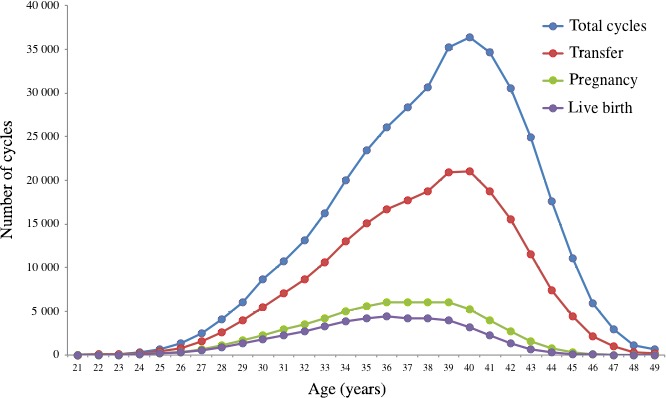
Age distribution of the women who were treated with assisted reproductive technology procedures in Japan in 2014. Adapted from Japan Society of Obstetrics and Gynecology ART Databook 2014 (https://plaza.umin.ac.jp/~jsog-art/2014data_201609.pdf)
Figure 2.
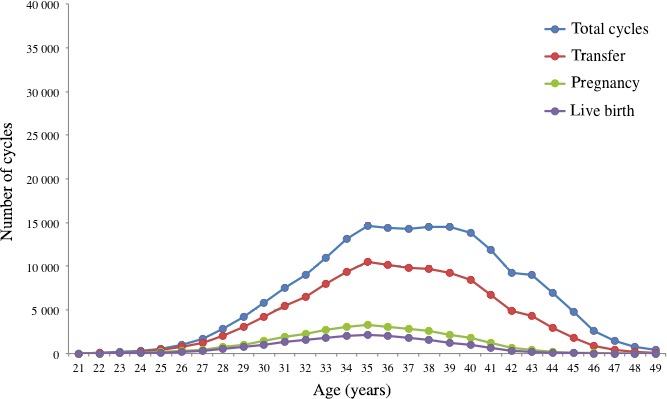
Age distribution of the women who were treated with assisted reproductive technology procedures in Japan in 2008. Adapted from Japan Society of Obstetrics and Gynecology ART Databook 2008 (https://plaza.umin.ac.jp/~jsog-art/2008data_pdf.pdf)
Figure 3.
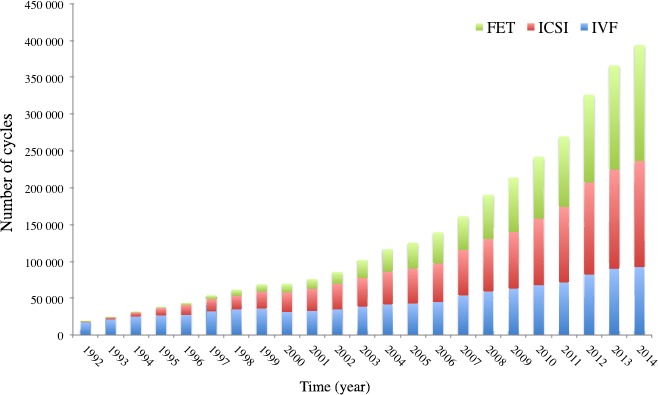
Number of cycles in each assisted reproductive technology procedure in Japan between 1992 and 2014. Adapted from Japan Society of Obstetrics and Gynecology ART Databook 2014 (https://plaza.umin.ac.jp/~jsog-art/2014data_201609.pdf). FET, frozen–thawed embryo transfer; ICSI, intracytoplasmic sperm injection; IVF, in vitro fertilization
Figure 4.
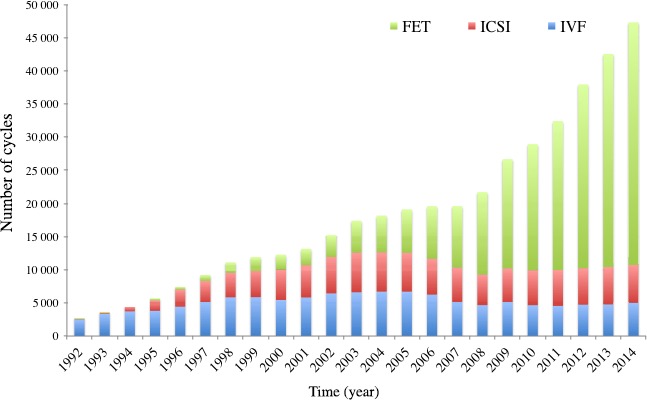
Number of live births after assisted reproductive technology procedures in Japan between 1992 and 2014. Adapted from Japan Society of Obstetrics and Gynecology ART Databook 2014 (https://plaza.umin.ac.jp/~jsog-art/2014data_201609.pdf). FET, frozen–thawed embryo transfer; ICSI, intracytoplasmic sperm injection; IVF, in vitro fertilization
Figure 5 shows the outcomes of ART by patient age for all treatment cycles. As the age increases, the success rate decreases and the rate of miscarriage increases. Compared to the 2008 results (Figure 6), these outcomes represent a slight increase, but no major change.
Figure 5.
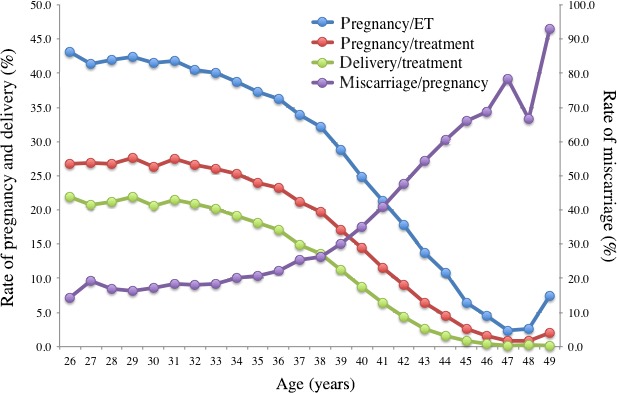
Rates of pregnancy, live birth, and miscarriage at each age in Japan in 2014. Adapted from Japan Society of Obstetrics and Gynecology ART Databook 2014 (https://plaza.umin.ac.jp/~jsog-art/2014data_201609.pdf). ET, embryo transfer
Figure 6.
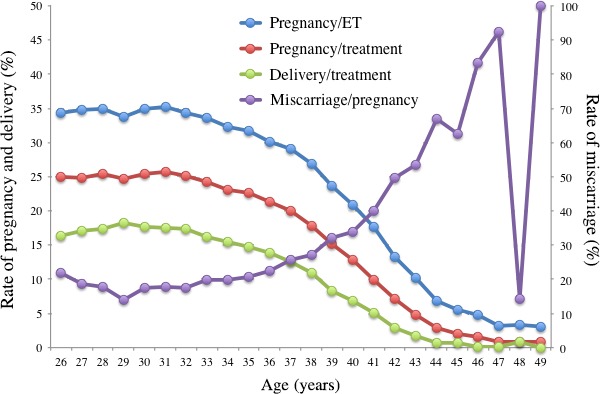
Rates of pregnancy, live birth, and miscarriage at each age in Japan in 2008. Adapted from Japan Society of Obstetrics and Gynecology ART Databook 2008 (https://plaza.umin.ac.jp/~jsog-art/2008data_pdf.pdf). ET, embryo transfer
Conflict of Interest
There is no conflict of interest regarding the publication of this study.
Human Rights Statement and Informed Consent
All the procedures that were followed were in accordance with the ethical standards of the responsible committees on human experimentation (institutional and national) and with the Helsinki Declaration of 1964 and its later amendments. Informed consent was obtained from all the patients in the study.
Animal rights
This article does not contain any study that was performed by any of the authors that included animal participants.
Acknowledgements
This report had the cooperation of all the registered facilities that provided responses. We would like to express our sincere gratitude to these facilities and we ask that they promote the use of the online registry system and continue to cooperate in our efforts.
Irahara M, Kuwahara A, Iwasa T, et al. Assisted reproductive technology in Japan: a summary report of 1992–2014 by the Ethics Committee, Japan Society of Obstetrics and Gynecology. Reprod Med Biol. 2017;16:126–132. doi:10.1002/rmb2.12014
References
- 1. Japan Society of Obstetrics and Gynecology . Committee report on the reproductive medicine registry. Acta Obstet Gynaecol Jpn. 1990;42:393–397 (in Japanese). [Google Scholar]
- 2. Japan Society of Obstetrics and Gynecology . Committee report (1990) on the reproductive medicine registry (results on clinical practice in 1989 and survey results on children born via infertility treatment as of the end of 1988). Acta Obstet Gynaecol Jpn. 1991;43:470–476 (in Japanese). [Google Scholar]
- 3. Japan Society of Obstetrics and Gynecology . Committee report (1991) on the reproductive medicine registry (3rd ed.) (results on clinical practice in 1990 and survey results on children born via infertility treatment in 1989). Acta Obstet Gynaecol Jpn. 1992;44:499–511 (in Japanese). [Google Scholar]
- 4. Japan Society of Obstetrics and Gynecology . Committee report (1992) on the reproductive medicine registry (4th ed.) (results on clinical practice in 1991, survey results on children born via infertility treatment in 1990, and results from comprehensive analysis of survey data on all children born via infertility treatment to date). Acta Obstet Gynaecol Jpn. 1993;45:397–410 (in Japanese). [Google Scholar]
- 5. Japan Society of Obstetrics and Gynecology . Ethics Committee report on medical care and research in 1993 (results on clinical application of in vitro fertilization and embryo transfer in 1992). Acta Obstet Gynaecol Jpn. 1994;46:929–933 (in Japanese). [Google Scholar]
- 6. Japan Society of Obstetrics and Gynecology . Ethics Committee report on medical care and research in 1994 (results on clinical application of in vitro fertilization and embryo transfer in 1993). Acta Obstet Gynaecol Jpn. 1995;47:444–448 (in Japanese). [Google Scholar]
- 7. Japan Society of Obstetrics and Gynecology . Ethics Committee report on medical care and research in 1995 (results on clinical application of in vitro fertilization and embryo transfer in 1994). Acta Obstet Gynaecol Jpn. 1996;48:365–371 (in Japanese). [Google Scholar]
- 8. Japan Society of Obstetrics and Gynecology . Ethics Committee report on medical care and research in 1996 (results on clinical application of in vitro fertilization and embryo transfer in 1995). Acta Obstet Gynaecol Jpn. 1997;49:697–702 (in Japanese). [Google Scholar]
- 9. Japan Society of Obstetrics and Gynecology . Ethics Committee report on medical care and research in 1997 (results on clinical application of in vitro fertilization and embryo transfer in 1996 and a list of registered institutions as of March 1998). Acta Obstet Gynaecol Jpn. 1998;50:267–277 (in Japanese). [Google Scholar]
- 10. Japan Society of Obstetrics and Gynecology . Ethics Committee report on medical care and research in 1998 (results on clinical application of in vitro fertilization and embryo transfer in 1997 and a list of registered institutions as of March 1999). Acta Obstet Gynaecol Jpn. 1999;51:361–394 (in Japanese). [Google Scholar]
- 11. Ethics Committee of the Japan Society of Obstetrics and Gynecology . Subcommittee report on registration and survey of ART in 1999 (results on clinical application of in vitro fertilization and embryo transfer in 1998 and a list of registered institutions as of March 2000). Acta Obstet Gynaecol Jpn. 2000;52:962–987 (in Japanese). [Google Scholar]
- 12. Ethics Committee of the Japan Society of Obstetrics and Gynecology . Subcommittee report on registration and survey of ART in 2000 (results on clinical application of in vitro fertilization and embryo transfer in 1999 and a list of registered institutions as of March 2001). Acta Obstet Gynaecol Jpn. 2001;53:1462–1493 (in Japanese). [Google Scholar]
- 13. Ethics Committee of the Japan Society of Obstetrics and Gynecology . Subcommittee report on registration and survey of ART in 2001–2002 (results on clinical application of in vitro fertilization and embryo transfer in 2000–2001 and a list of registered institutions as of March 2003). Acta Obstet Gynaecol Jpn. 2003;55:1272–1287 (in Japanese). [Google Scholar]
- 14. Ethics Committee of the Japan Society of Obstetrics and Gynecology . Subcommittee report on registration and survey of ART in 2003 (results on clinical application of in vitro fertilization and embryo transfer in 2002 and a list of registered institutions as of October 2004). Acta Obstet Gynaecol Jpn. 2005;57:118–146 (in Japanese). [Google Scholar]
- 15. Ethics Committee of the Japan Society of Obstetrics and Gynecology . Subcommittee report on registration and survey of ART in 2004 (results on clinical application of in vitro fertilization and embryo transfer in 2003 and a list of registered institutions as of June 2005). Acta Obstet Gynaecol Jpn. 2005;57:1601–1629 (in Japanese). [Google Scholar]
- 16. Ethics Committee of the Japan Society of Obstetrics and Gynecology . Subcommittee report on registration and survey of ART in 2005 (results on clinical application of in vitro fertilization and embryo transfer in 2004 and a list of registered institutions as of June 2006). Acta Obstet Gynaecol Jpn. 2006;58:1554–1579 (in Japanese). [Google Scholar]
- 17. Ethics Committee of the Japan Society of Obstetrics and Gynecology . Subcommittee report on registration and survey of ART in 2006 (results on clinical application of in vitro fertilization and embryo transfer in 2005 and a list of registered institutions as of July 2007). Acta Obstet Gynaecol Jpn. 2007;59:1717–1739 (in Japanese). [Google Scholar]
- 18. Ethics Committee of the Japan Society of Obstetrics and Gynecology . Subcommittee report on registration and survey of ART in 2007 (results on clinical application of in vitro fertilization and embryo transfer in 2006 and a list of registered institutions as of March 2008). Acta Obstet Gynaecol Jpn. 2008;60:1230–1253 (in Japanese). [Google Scholar]
- 19. Ethics Committee of the Japan Society of Obstetrics and Gynecology . Subcommittee report on registration and survey of ART in 2008 (results on clinical application of in vitro fertilization and embryo transfer in 2007 and a list of registered institutions as of July 2009). Acta Obstet Gynaecol Jpn. 2009;61:1853–1880 (in Japanese). [Google Scholar]
- 20. Ethics Committee of the Japan Society of Obstetrics and Gynecology . Subcommittee report on registration and survey of ART in 2009 (results on clinical application of in vitro fertilization and embryo transfer in 2008 and a list of registered institutions as of July 2010). Acta Obstet Gynaecol Jpn. 2010;62:1821–1848 (in Japanese). [Google Scholar]
- 21. Ethics Committee of the Japan Society of Obstetrics and Gynecology . Subcommittee report on registration and survey of ART in 2010 (results on clinical application of in vitro fertilization and embryo transfer in 2009 and a list of registered institutions as of July 2011). Acta Obstet Gynaecol Jpn. 2011;63:1881–1911 (in Japanese). [Google Scholar]
- 22. Ethics Committee of the Japan Society of Obstetrics and Gynecology . Subcommittee report on registration and survey of ART in 2011 (results on clinical application of in vitro fertilization and embryo transfer in 2010 and a list of registered institutions as of July 2012). Acta Obstet Gynaecol Jpn. 2012;64:2110–2140 (in Japanese). [Google Scholar]
- 23. Ethics Committee of the Japan Society of Obstetrics and Gynecology . Subcommittee report on registration and survey of ART in 2012 (results on clinical application of in vitro fertilization and embryo transfer in 2011 and a list of registered institutions as of July 2013). Acta Obstet Gynaecol Jpn. 2013;65:2083–2115 (in Japanese). [Google Scholar]
- 24. Ethics Committee of the Japan Society of Obstetrics and Gynecology . Subcommittee report on registration and survey of ART in 2013 (results on clinical application of in vitro fertilization and embryo transfer in 2012 and a list of registered institutions as of July 2014). Acta Obstet Gynaecol Jpn. 2014;66:2445–2481 (in Japanese). [Google Scholar]
- 25. Ethics Committee of the Japan Society of Obstetrics and Gynecology . Subcommittee report on registration and survey of ART in 2014 (results on clinical application of in vitro fertilization and embryo transfer in 2013 and a list of registered institutions as of July 2015). Acta Obstet Gynaecol Jpn. 2015;67:2077–2121. [Google Scholar]


